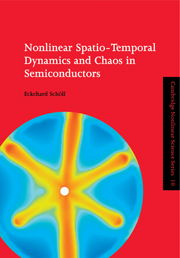Book contents
- Frontmatter
- Contents
- Preface
- Chapter 1 Semiconductors as continuous nonlinear dynamic systems
- Chapter 2 Concepts of nonlinear charge transport in semiconductors
- Chapter 3 Pattern formation and oscillatory instabilities in semiconductors
- Chapter 4 Impact-ionization-induced impurity breakdown
- Chapter 5 Nonlinear carrier dynamics in crossed electric and magnetic fields
- Chapter 6 Stationary and oscillating domains in superlattices
- Chapter 7 Spatio-temporal chaos
- References
- Index
Chapter 5 - Nonlinear carrier dynamics in crossed electric and magnetic fields
Published online by Cambridge University Press: 17 September 2009
- Frontmatter
- Contents
- Preface
- Chapter 1 Semiconductors as continuous nonlinear dynamic systems
- Chapter 2 Concepts of nonlinear charge transport in semiconductors
- Chapter 3 Pattern formation and oscillatory instabilities in semiconductors
- Chapter 4 Impact-ionization-induced impurity breakdown
- Chapter 5 Nonlinear carrier dynamics in crossed electric and magnetic fields
- Chapter 6 Stationary and oscillating domains in superlattices
- Chapter 7 Spatio-temporal chaos
- References
- Index
Summary
It has been found experimentally that an external magnetic field applied perpendicular to the electric field can sensitively affect the spatio-temporal instabilities in the regime of impurity-impact ionization. For instance, it has been observed that even a relatively weak magnetic field can induce complex chaotic current oscillations. In this chapter we study the nonlinear and chaotic dynamics of carriers in crossed electric and magnetic fields. We present a general framework for the description of a dynamic Hall instability, and apply it in particular to the conditions of low-temperature impurity breakdown. We show that chaos control by time-delayed feedback can stabilize those chaotic oscillations. Furthermore, we discuss the complex spatio-temporal dynamics of current filaments in a Hall configuration, resulting either in lateral motion or in a deformation of the filamentary patterns.
Introduction
Ever since E. H. Hall discovered in 1879 the effect which bears his name, galvanomagnetic phenomena in solids have received significant attention. The Hall effect has been used as an important probe of material properties in many branches of solid-state physics, and more than 200 million components of devices successfully utilize the Hall effect (Chien and Westgate 1980).
Along with the development of practical uses of the Hall effect, the theoretical foundation of galvanomagnetic phenomena has been established (Madelung 1957). Interest has recently been revived strongly by the extension of the classical Hall effect into the regime of the integral (von Klitzing 1990) or fractional (Eisenstein and Störmer 1990) quantum Hall effect, and by the discovery of the negative Hall effect and chaotic dynamics in lateral superlattices (Fleischmann et al. 1994, Schöll 1998b).
- Type
- Chapter
- Information
- Nonlinear Spatio-Temporal Dynamics and Chaos in Semiconductors , pp. 220 - 261Publisher: Cambridge University PressPrint publication year: 2001



